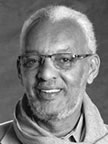WEB EXTRA~
 Teshome H. Gabriel BA’67 MEd’69, an internationally recognized scholar of Third World cinema, died June 14 of sudden cardiac arrest. He was 70.
Teshome H. Gabriel BA’67 MEd’69, an internationally recognized scholar of Third World cinema, died June 14 of sudden cardiac arrest. He was 70.
Gabriel was born Sept. 24, 1939, in the small town of Ticho, Ethiopia, and came to the United States in 1962. He received a bachelor’s degree in political science from the University of Utah followed by a master’s of education in educational media. At UCLA, he received a master’s degree in theater arts (film/television) in 1976 and his doctorate in film and television studies in 1979.
Gabriel, who began as a lecturer at UCLA in 1974 before becoming an assistant professor in 1981, was one of the first scholars to theorize in a critical fashion about Third World cinema and became a principal exponent of the idea of Third Cinema, which he identified as having its own conventions of narrative and style and an aesthetic tied to a politics of social action. He was the author of the 1982 book Third Cinema in the Third World: The Aesthetics of Liberation, co-edited the 1993 book Otherness and the Media: The Ethnography of the Imagined and the Imaged, and most recently wrote the book Third Cinema: Exploration of Nomadic Aesthetics & Narrative Communities. His many other accomplishments included serving as editor in chief of Emergences: Journal for the Study of Media and Composite Cultures. He also was founder and an editorial board member of Tuwaf (Light), an Ethiopian fine arts journal in Amharic, from 1987 to 1991.
In his later years, Gabriel wrote on such things as the relationship of the Web to weaving, the idea of the nomadic (and the transgressive), and the relationship between the built form and ruins.
Teshome Gabriel is survived by his wife, Maaza Woldemusie; daughter Mediget; and son Tsegaye.
Edited from the 6/17/10 article in the Los Angeles Times.
 Peter Heilbrun, a leading brain surgeon and former chair of the University of Utah’s Department of Neurosurgery, died at home in Sausalito, Calif., on Sept. 27 surrounded by his family. He was 73.
Peter Heilbrun, a leading brain surgeon and former chair of the University of Utah’s Department of Neurosurgery, died at home in Sausalito, Calif., on Sept. 27 surrounded by his family. He was 73.
M. Peter Heilbrun was born on March 23, 1937, in Buffalo, N.Y., to Evelyn and Norman Heilbrun, and has one younger sister, Robie (Bill) Harris. After a liberal arts undergraduate career at Brown University in Rhode Island, Peter went to medical school at State University of New York, Buffalo, graduating in 1962. He began his training in general surgery, but after two years elected to transfer to neurosurgery. Prior to beginning a neurosurgery residency at Washington University, St. Louis, he spent two years in the Navy, first on the USS Topeka in 1964 and then as the medical officer at in the San Francisco Naval Shipyard at Hunter’s Point. In St. Louis, he met the love of his life, Robyn (neé Ory), and they were married in 1970.
Peter served most of his medical career at the University of Utah in Salt Lake City, where he was chair of the Department of Neurosurgery from 1983-2000. Peter was a leader in the field of neurosurgery, spearheading the move toward minimally invasive and image-guided techniques. In his professional realm, he was considered a true renaissance man, a great surgeon, physician, leader, and mentor. Outside of the medical environment, Peter was an avid skier, sailor, and artist who took up watercolor painting to fill the in-between seasons during his retirement. He embraced life to the fullest, traveling, experiencing, and sharing the world with his family and friends.
Peter is survived by his wife, daughters Sarah Kate (David Gross) and Marta (Ron Penner), and three grandchildren, and his sister and her family. His parents preceded him in death.
Peter believed in the responsibility each of us has to bring out the best in each other. In lieu of flowers, the family suggests a donation in his name to a charity or cause that is important in your life.
Edited from the memorial notice published by the University of Utah Clinical Neurosciences Center.
 Matthew Simmons BS’65, founder of one of the earliest investment banking boutiques focused on the energy sector and a major proponent of the idea of “peak oil,” died unexpectedly on August 8. He was 67.
Matthew Simmons BS’65, founder of one of the earliest investment banking boutiques focused on the energy sector and a major proponent of the idea of “peak oil,” died unexpectedly on August 8. He was 67.
In Houston in 1974, Simmons founded Simmons & Company, a specialized energy investment banking firm that grew to count among its clients General Electric and the World Bank and opened offices in London, Aberdeen, and Dubai. When he retired from Simmons & Co in June 2010, the firm had completed 785 investment banking projects for worldwide energy clients at a combined dollar of more than $140 billion. Simmons served as an energy-policy adviser to the 2000 Bush-Cheney campaign, and also authored the 2005 book Twilight in the Desert: The Coming Saudi Oil Shock and the World Economy, which has been listed on the Wall Street Journal’s best-seller list. Simmons’ most recent project was the Ocean Energy Institute, a Rockport, Maine, organization that is a think tank and venture capital fund advocating alternative energy. He was the organization’s chair, president, and treasurer. Simmons was recognized as a University of Utah Distinguished Alumnus in 2006.
Simmons was raised in Kaysville, Utah. He graduated cum laude from the University of Utah and received an MBA from Harvard Business School.
Matt Simmons is survived by his wife, Ellen, and five daughters.
Edited from numerous news sources.